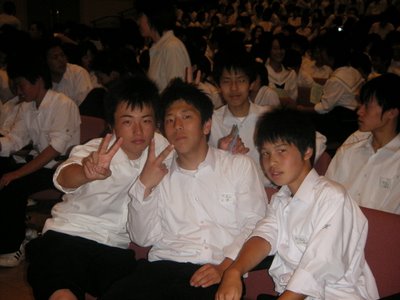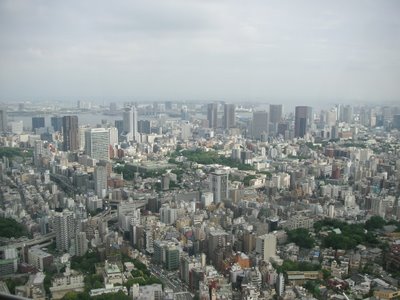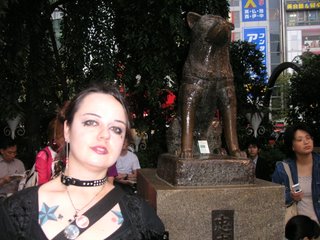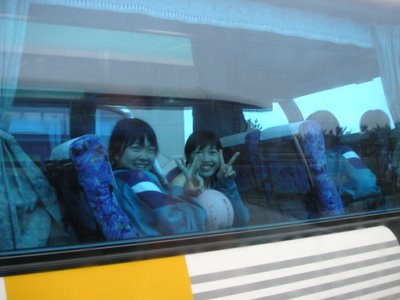Each year in May, Harue JHS students go on a school trip. The 3 nen sei students (equivalent to American high school freshmen) go to Tokyo. They go away for about three days, stay in a nice hotel, go signtseeing around the city, and of course visit Tokyo Disneyland. The 1 and 2 nen sei (American 7th/ 8th graders) also get to go on a school trip, but only for one day.
In Japanese schools the staff is also divided into 1, 2, and 3 nen sei teachers. This does not reflect at all how many years they have been at the school. The teachers are assigned a grade each year at the start of the year. Homeroom teachers are obviously placed in the same grade as their homeroom's year. During assemblies, enkais (work parties), and school trips the teachers sit in their grade group. For whatever reason, the ALT at my school is always assigned to the 1 nen sei group. So each year I go on the school trip with the 7th graders, and never with the 9th graders that go to Tokyo.
This May, the 3 nen sei teachers and students went to Tokyo as always. The 2 nen sei group went someplace (I don't even know where) and had a BBQ. While the 1 nen seis and I went to a park in Ishikawa (ken) Prefecture.
Ishikawa ken is just north of Fukui ken, and since I live in the north of Fukui it's not a very far. For our trip we went up to Matto Coast Seaside Park just outside of Kanazawa City. The drive was about an hour long, but the students entertained themselves on the buses. They sing songs, play cards, read books, talk to their friend, or sleep. Each homeroom had a separate bus. In my school there are 273 1 nen sei students, that brakes down into 9 homerooms- each with about 30 students. The homeroom teachers ride with on the bus with their class and the other teachers get assigned a class. I was placed with homeroom 1-2, definantly because the homeroom teacher is an English teacher.
 Some 1 nen sei students eatting their bentos (box lunches).
Some 1 nen sei students eatting their bentos (box lunches).After lunch, we played a few group games. The first game was a bit strange, so I'll do my best to explain. Everyone (students and teachers) recieved colored (different color per class) strips of plastic that they tucked in their pants to look like tails. 3 teams (classes) would spread out at different parts of the park. When a whisle was blown the teams out on the field had to get the tails of other players (students/teachers) and they had to try to keep theirs. After another whistle, the 3 teams returned and counted how many tails they had. Then the next 3 teams went out. After that there were finals for the the worst three teams, then those that came in 2nd in their group, and then the finals to determine the 1st,2nd, and 3rd place teams. My team didn't do so hot and we finished 8th (only one away from last place).
After this we played soccer, although again it was in groups of three teams. There were three goals on each field and a number of balls in play. I had alot more fun playing soccer cause I knew the rules and what to do-- although only the kids that liked soccer ran around the rest huddled in front of their goal to defend it.After the soccer game the students were free to run around and play, while the teachers just sat around and talked-- or snuck off to the beach for a smoke. I wandered around, talked with some students, played frisbee with one lonely student, and then volleyball with a few girls. I also wandered around a bit and took some pictures of the beach area.
 As you can see the students have to wear a school uniform on the trip. They don't wear their regular uniforms. They were their gym uniforms. These are the same uniforms they were in Phys. Ed class and for cleaning time. Yes, everyday the students have "cleaning time," and they have to clean the school-- or pretend that they're cleaning.
As you can see the students have to wear a school uniform on the trip. They don't wear their regular uniforms. They were their gym uniforms. These are the same uniforms they were in Phys. Ed class and for cleaning time. Yes, everyday the students have "cleaning time," and they have to clean the school-- or pretend that they're cleaning.
Some of my 1 nen sei girls posing for a pic. =)

You probably also noticed that almost every kid or teacher in every picture is holdin up a peace sign. This is the "in thing" in Japan, and everyone does it in pics. I don't know why, nor do I know why I find myself doing it.

Students from class 1-2 on the bus.

The park we spent the entire school trip at had this big windmill (just for show, it doesn't work). Anyway, each class posed for a pic in front of it. That's homeroom 1-3 with their teacher, Mr. Kondo.

All the kids packed small tarps to sit on, a lunch, some snacks, and stuff to do.

Back at the school, after the trip we had to have a "closing the school trip ceremony." We also had one of these at the start of the day. The Japanese are very big on formal beginings of all non-daily events. We have an opening and closing cermony for the start and end of each semester, school trips, work parties, sports day, culture day, and everything else that you can think of. It was a bit strange at first, but I got used to it.
This year's school trip wasn't so interesting. Last year in May, we also went up to Ishikawa-ken but we went bowling and competed against each other and then we drove over to a big park for lunch and free time. Well, there will be another school trip in October-- maybe that one will be more interesting.







































